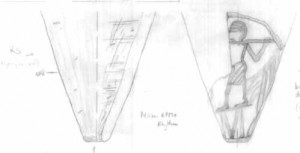Additionally to processing the find from our current excavations at SAV1 East and SAV1 West, we continue, like in 2013, documenting material which was excavated in SAV1 North in the last years by Florence Doyen.
Nicole, Julia and Elke have been very busy in the last weeks and I would like to present one of the masterpieces. This unique fragment also nicely illustrates why detailed drawings of pottery vessels are simply necessary in additions to photos: technical and morphological details, the general shape and also the outline of decorative patterns can be best clarified with a drawing in 1:1.
Elke have been very busy in the last weeks and I would like to present one of the masterpieces. This unique fragment also nicely illustrates why detailed drawings of pottery vessels are simply necessary in additions to photos: technical and morphological details, the general shape and also the outline of decorative patterns can be best clarified with a drawing in 1:1.
The important piece recently documented with an accurate drawing by Nicole is a lower part of a decorated rhyton, covered in a red slip and burnished, made in a very fine Nile B (SAV1N N/C 1205). The area around the perforated bottom of this vessel is painted in black with floral elements. Just above these lotus flowers a register with figural painting is still partly visible. According to the remains it seems to be a scene in the marshes: a striding male figure is carrying something with a pole set on his shoulder. Maybe the hanging objects are large fishes? Nicole is still not completly convinced and I must admit that her nice drawing also raised some doubts for my interpretation.
As I have stressed in an earlier post, rhytons like N/C 1205 had the character of luxury items in 18th Dynasty Egypt, the vessel shape being characteristically Aegean. Our small masterpiece from SAV1 North is an Egyptian copy in Nile clay of a Late Minoan IA rhyton.


Very happy that this great piece of pottery also excites others:
Hi Julia! Here are my comments from twitter (and now I’m not limited to 140 characters!).
I looked through Robert Koehl’s book, Aegean Bronze Age Rhyta (INSTAP, 2006) quickly tonight. And it seems from his figures and plates that there are few human figures on ceramic conical rhyta and those seem to date to LH IIIA2 (Koehl’s cat no 608 and 719). There are, of course, carved human relief figures on the Boxer (conical) rhyton which dates to LM IA and is made of serpentinite. And there are some serpentinite fragments from Knossos and date to LM I (also cataloged in Koehl’s book, pp. 179-181, cat nos: 763, 764, 765, 766, 767, 768, 769, & 770). Unfortunately, Koehl doesn’t have a table detailing the motfis on rhyta and rhyta types.
There may be some more examples from the mainland with human figures, and those would probably be cataloged in Penelope Mountjoy’s 1999 Regional Mycenaean Decorated Pottery, which one would have to pretty much look up every rhyton in the the two (large) volumes. LM I ceramic examples documented outside of Koehl’s volume would require digging through individual Cretan site reports and articles.
I did my PhD thesis on LBA Aegean ceramics excavated from New Kingdom Egypt and Nubia. I have a database of over 1,600 entries, and then shape, maps, and things. I checked my db and it seems that there was a LH III conical stirrup jar found in tomb SA. C5-T.21 (although you probably already know that!).
I hope this helps. Yes, please do contact me! Cheers, Beth Ann
Great, very much appreciated, Beth Ann! Will check all the references once I am back in Vienna in March! And yes, our small rhyton is really intriguing and exciting!
The stirrup jar from tomb SAC5 21 was recently published by Ann Minault-Gout and Florence Thill in Sai II (2012); we found a small fragment of a base of a stirrup jar 3 years ago in the town, in the area SAV1 North! Sai really seems to have many highly highlights, including Aegean connections!